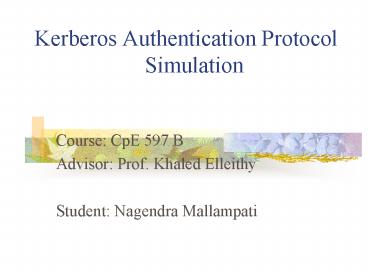Kerberos Authentication Protocol Simulation PowerPoint PPT Presentation
1 / 32
Title: Kerberos Authentication Protocol Simulation
1
Kerberos Authentication Protocol Simulation
- Course CpE 597 B
- Advisor Prof. Khaled Elleithy
- Student Nagendra Mallampati
2
Abstract
- Windows 2000 implements kerberos version 5 with
extensions for publickey authentication.The
kerberos client is implemented as a security
provider through the Secutiry Service Provider
Interface.Initial authentication is intergrated
with winlogon single sign-on architecture.The
Kerberos Distribution Center(KDC) is integrated
with other windows 2000 security services running
on the domain controller and uses the domains
Active Directory as its security account database
.
3
Goals of the Project
- To simulate the Kerberos Authentication Protocol
using GSS-API. - To show the different types of Security attacks
in a GUI.
4
Figure used for Simulation
5
Scenario in the figure
- User logs on to the work station and requests
service on the host. - AS verifies users access right in the
database,creates TGT and session key.Results are
encrypted using key derived from users password. - Workstation prompts user for password and
decrypts and sends ticket and authenticator to
TGS.
6
Scenario contd
- TGS decrypts ticket and authenticator,verifies
request and creates ticket for the requested
server. - Workstation sends ticket ticket and authenticator
to server. - Server verifies that ticket and authenticator
match,then grants access to service.
7
What is Kerberos?
- Network Authentication Protocol.
- Developed at MIT in the mid 1980s.
- Available as open source or in supported
commercial software.
8
How did Kerberos get its name?
- The name "Kerberos" comes from a
- mythological three-headed dog that
- guarded the entrance
- to Hades. Invented by MIT,
- this form of security
- has been evolving
- in the Unix world for over a
- decade and is now becoming a standard .
9
Why Kerberos?
- Sending usernames and passwords in the clear
jeopardizes the security of the network. - Each time a password is sent in the clear,there
is a chance of an security attack.
10
Types of Security Attacks
- Interception an attack on confidentiality.
- Interruption an attack of availability.
- Modification an attack on integrity.
- Fabrication an attack on authenticity.
11
Firewall Vs Kerberos ?
- Firewalls make a risky assumptionthat attackers
come from outside.In reality,attacks frequently
come from within. - Kerberos assumes that network connections(rather
than servers and workstations)are the weak link
in network security.
12
Design Requirements
- Interactions between hosts and clients should be
encrypted. - Must be convenient for users.
- Protect against intercepted credentials.
13
How does Kerberos work?
- Instead of client sending password to application
server - -Request Ticket from authentication
server. - - Ticket and encrypted request sent to
the application server. - How to request tickets without repeatedly sending
credentials? - - Ticket Granting Ticket(TGT).
14
Terms used in Kerberos
- REALM It could be termed as a group''.
Machines will belong to this group. It has
become almost standard procedure to make the
realm the same as your domain name. - KDC the Kerberos Distribution Center , This is
the machine that controls access. - KEYTAB a file that contains encrypted
information allowing users/machines to
authenticate themselves.
15
Limitations of Kerberos
- Scalability.
- Doesnt explicitly protect against Trojan
attacks. - Is mainly intended for single-user workstations.
- KDC can be a single point of failure.
16
Benefits of Kerberos Authentication
- More efficient authentication to servers
- Mutual authentication
- Delegated authentication
- Simplified trust management
- Interoperability
17
Applications of Kerberos
- The Kerberos V5 applications are versions
- of existing UNIX network programs with the
Kerberos features added. - telnet
- rlogin
- FTP
- rsh
- rcp
- ksu
18
GSS-API
- Provides the way for applications to protect data
that is sent to peer applications. - Enables application control over secutiry
aspects. - More portable as regards to Network Security.
19
Functions of GSS-API
- Creates a security context in which data can be
passed btween apllications. - Applies one or more types of protection,known as
security services,to the data to be transmitted.
20
Screenshots of the Project
- Without Kerberos (Security Attacks)
- With Kerberos.
21
(No Transcript)
22
(No Transcript)
23
(No Transcript)
24
(No Transcript)
25
(No Transcript)
26
(No Transcript)
27
(No Transcript)
28
(No Transcript)
29
(No Transcript)
30
(No Transcript)
31
Conclusions
It can be concluded that kerberos,
when intergrated with other parts of the system,
can be made more useful . By implementing
Kerberos in Windows 2000 the authentication
process was extended.Kerberos is made a default
authorization service for windows 2000 as it
ensures a trustworthy authorization and more
secure.
32
References
Books Network Security
Essentials- William Stallings.
Websites http//java.sun.com/j2se/1.4.1/docs/ h
ttp//www.ietf.org/rfc/rfc2853.txt http//www.win
dowsitlibrary.com/Content/617/06/3.html5 http//
mit.edu/kerberos/www/ http//www.labmice.net/Secu
rity/kerberos.htm http//portal.acm.org/dl.cfm

